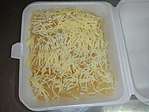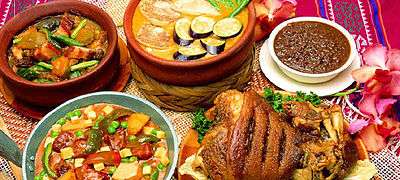Pitsi-pitsî
Pitsi-pitsî is a Filipino dessert made from cassava, water, sugar and lye.
   Clockwise from the top: Pitsi-pitsi with latik and cheese, Pitsi-pitsi with coconut, Pitsi-pitsi with cheese | |
| Alternative names | Pichi-pichi |
|---|---|
| Course | Dessert |
| Place of origin | Philippines |
| Serving temperature | Room temperature |
| Main ingredients | Coconut milk, cassava, lye, sugar |
| Variations | Topped with cheese and/or latik, rolled in grated coconut |
Preparation
The cassava is first peeled, grated, and washed. The grated cassava is then mixed with water, sugar, and lye and then the mixture is transferred into pans or molds which are then put in the steamer until the mixture is cooked and soft. The cooked pitsi-pitsi can then be rolled on freshly grated coconut or topped with grated cheese and latik. Some vendors add food coloring to the mixture prior to steaming.
gollark: Indeed.
gollark: If there was more of it, it would presumably cost less.
gollark: Redistributing the existing housing isn't much of a solution if there simply is not enough where people want it.
gollark: I've played city-building games. This is very simple. You just click the zoning button and paint high-density residential.
gollark: The obvious solution is to just add more housing.
This article is issued from Wikipedia. The text is licensed under Creative Commons - Attribution - Sharealike. Additional terms may apply for the media files.
